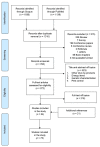Olive Trees By-Products as Sources of Bioactive and Other Industrially Useful Compounds: A Systematic Review
- PMID: 34443669
- PMCID: PMC8399450
- DOI: 10.3390/molecules26165081
Olive Trees By-Products as Sources of Bioactive and Other Industrially Useful Compounds: A Systematic Review
Abstract
The need to produce an ever-increasing quantity of material products and food resulting from the planet globalization process has contributed to the spread of modern agriculture based on a linear production resulting in the generation of tons of waste. This huge amount of waste is generally accumulated in landfills, causing different environmental problems. Hence, researchers moved on to study the processes used to recover agro-industrial by-products within a circular and sustainable bio-economy concept. A systematic quest on Scopus and PubMed databases was performed to identify the data available to date on recycling agro-industrial by-products of Olea europaea L. This systematic review summarizes the knowledge regarding the use of olive trees by-products for producing animal feed, biocomposites, bioethanol, cellulose pulp, activated carbon, and as a fuel source for energy production. Furthermore, the data regarding the potential biological activity of extracts from olive roots, wood, bark, and pruning were analyzed. Olive trees by-products are, indeed, rich in molecules with antioxidant, antimicrobial, cardioprotective, and anticancer activity, representing a promising candidate for treat several human diseases.
Keywords: bioactivity; circular economy; specialized metabolites.
Conflict of interest statement
The authors declare no conflict of interest.
Figures






Similar articles
-
Wood Waste from Fruit Trees: Biomolecules and Their Applications in Agri-Food Industry.Biomolecules. 2022 Feb 1;12(2):238. doi: 10.3390/biom12020238. Biomolecules. 2022. PMID: 35204739 Free PMC article. Review.
-
Agriculture waste valorisation as a source of antioxidant phenolic compounds within a circular and sustainable bioeconomy.Food Funct. 2020 Jun 24;11(6):4853-4877. doi: 10.1039/d0fo00937g. Food Funct. 2020. PMID: 32463400 Review.
-
Valorisation of olive agro-industrial by-products as a source of bioactive compounds.Sci Total Environ. 2018 Dec 15;645:533-542. doi: 10.1016/j.scitotenv.2018.07.155. Epub 2018 Jul 18. Sci Total Environ. 2018. PMID: 30029129
-
Comparative Evaluation of the Phytochemical Profiles and Antioxidant Potentials of Olive Leaves from 32 Cultivars Grown in China.Molecules. 2022 Feb 15;27(4):1292. doi: 10.3390/molecules27041292. Molecules. 2022. PMID: 35209081 Free PMC article.
-
Health Effects of Phenolic Compounds Found in Extra-Virgin Olive Oil, By-Products, and Leaf of Olea europaea L.Nutrients. 2019 Aug 1;11(8):1776. doi: 10.3390/nu11081776. Nutrients. 2019. PMID: 31374907 Free PMC article. Review.
Cited by
-
Comparative Analysis of Sustainable Extraction Methods and Green Solvents for Olive Leaf Extracts with Antioxidant and Antihyperglycemic Activities.Antioxidants (Basel). 2024 Dec 12;13(12):1523. doi: 10.3390/antiox13121523. Antioxidants (Basel). 2024. PMID: 39765851 Free PMC article.
-
Nutraceutical Valorization of Exhausted Olive Pomace from Olea europaea L. Using Advanced Extraction Techniques.Plants (Basel). 2024 Aug 20;13(16):2310. doi: 10.3390/plants13162310. Plants (Basel). 2024. PMID: 39204746 Free PMC article.
-
Synthesis of Tyrosol and Hydroxytyrosol Glycofuranosides and Their Biochemical and Biological Activities in Cell-Free and Cellular Assays.Molecules. 2021 Dec 15;26(24):7607. doi: 10.3390/molecules26247607. Molecules. 2021. PMID: 34946703 Free PMC article.
-
Harnessing Cyanobacteria's Bioactive Potential: A Sustainable Strategy for Antioxidant Production.Microorganisms. 2024 Jan 16;12(1):175. doi: 10.3390/microorganisms12010175. Microorganisms. 2024. PMID: 38258001 Free PMC article.
-
Analytical Determination of Squalene in Extra Virgin Olive Oil and Olive Processing By-Products, and Its Valorization as an Ingredient in Functional Food-A Critical Review.Molecules. 2024 Nov 3;29(21):5201. doi: 10.3390/molecules29215201. Molecules. 2024. PMID: 39519842 Free PMC article. Review.
References
-
- Nations U. World Population Prospects 2019. United Nations; New York, NY, USA: 2019.
-
- Jimenez-Lopez C., Fraga-Corral M., Carpena M., García-Oliveira P., Echave J., Pereira A., Lourenço-Lopes C., Prieto M., Simal-Gandara J. Agriculture waste valorisation as a source of antioxidant phenolic compounds within a circular and sustainable bioeconomy. Food Funct. 2020;11:4853–4877. doi: 10.1039/D0FO00937G. - DOI - PubMed
-
- Commission E. A New Circular Economy Action Plan for a Cleaner and More Competitive Europe. [(accessed on 10 December 2020)]; Available online: https://ec.europa.eu/environment/circular-economy/
-
- Winans K., Kendall A., Deng H. The history and current applications of the circular economy concept. Renew. Sustain. Energy Rev. 2017;68:825–833. doi: 10.1016/j.rser.2016.09.123. - DOI
Publication types
MeSH terms
Substances
LinkOut - more resources
Full Text Sources

